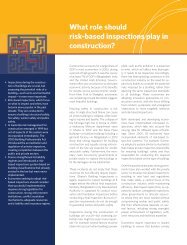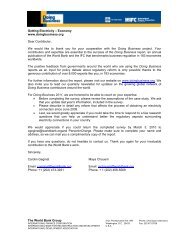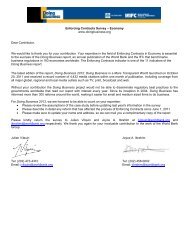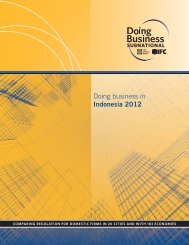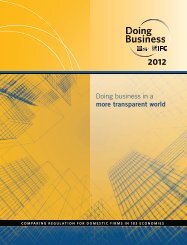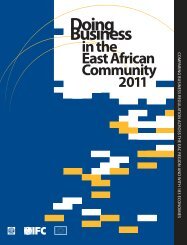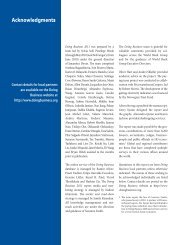Economy Profile: Burundi - Doing Business
Economy Profile: Burundi - Doing Business
Economy Profile: Burundi - Doing Business
Create successful ePaper yourself
Turn your PDF publications into a flip-book with our unique Google optimized e-Paper software.
<strong>Doing</strong> <strong>Business</strong> 2013<br />
<strong>Burundi</strong><br />
109<br />
representative samples of respondents is not an issue;<br />
<strong>Doing</strong> <strong>Business</strong> is not a statistical survey, and the texts<br />
of the relevant laws and regulations are collected and<br />
answers checked for accuracy. The methodology is<br />
inexpensive and easily replicable, so data can be<br />
collected in a large sample of economies. Because<br />
standard assumptions are used in the data collection,<br />
comparisons and benchmarks are valid across<br />
economies. Finally, the data not only highlight the<br />
extent of specific regulatory obstacles to business but<br />
also identify their source and point to what might be<br />
reformed.<br />
Information on the methodology for each <strong>Doing</strong><br />
<strong>Business</strong> topic can be found on the <strong>Doing</strong> <strong>Business</strong><br />
website at http://www.doingbusiness.org/methodology/.<br />
Limits to what is measured<br />
The <strong>Doing</strong> <strong>Business</strong> methodology has 5 limitations that<br />
should be considered when interpreting the data. First,<br />
the collected data refer to businesses in the economy’s<br />
largest business city (which in some economies differs<br />
from the capital) and may not be representative of<br />
regulation in other parts of the economy. To address<br />
this limitation, subnational <strong>Doing</strong> <strong>Business</strong> indicators<br />
were created (see the section on subnational <strong>Doing</strong><br />
<strong>Business</strong> indicators). Second, the data often focus on a<br />
specific business form—generally a limited liability<br />
company (or its legal equivalent) of a specified size—<br />
and may not be representative of the regulation on<br />
other businesses, for example, sole proprietorships.<br />
Third, transactions described in a standardized case<br />
scenario refer to a specific set of issues and may not<br />
represent the full set of issues a business encounters.<br />
Fourth, the measures of time involve an element of<br />
judgment by the expert respondents. When sources<br />
indicate different estimates, the time indicators<br />
reported in <strong>Doing</strong> <strong>Business</strong> represent the median<br />
values of several responses given under the<br />
assumptions of the standardized case.<br />
Finally, the methodology assumes that a business has<br />
full information on what is required and does not<br />
waste time when completing procedures. In practice,<br />
completing a procedure may take longer if the<br />
business lacks information or is unable to follow up<br />
promptly. Alternatively, the business may choose to<br />
disregard some burdensome procedures. For both<br />
reasons the time delays reported in <strong>Doing</strong> <strong>Business</strong><br />
2013 would differ from the recollection of<br />
entrepreneurs reported in the World Bank Enterprise<br />
Surveys or other perception surveys.<br />
Subnational <strong>Doing</strong> <strong>Business</strong> indicators<br />
This year <strong>Doing</strong> <strong>Business</strong> completed subnational<br />
studies for Indonesia, Kenya, Mexico, the Russian<br />
Federation and the United Arab Emirates. Each of<br />
these countries had already asked to have subnational<br />
data in the past, and this year <strong>Doing</strong> <strong>Business</strong> updated<br />
the indicators, measured improvements over time and<br />
expanded geographic coverage to additional cities or<br />
added additional indicators. <strong>Doing</strong> <strong>Business</strong> also<br />
published regional studies for the Arab world, the East<br />
African Community and member states of the<br />
Organization for the Harmonization of <strong>Business</strong> Law in<br />
Africa (OHADA).<br />
The subnational studies point to differences in<br />
business regulation and its implementation—as well as<br />
in the pace of regulatory reform—across cities in the<br />
same economy. For several economies subnational<br />
studies are now periodically updated to measure<br />
change over time or to expand geographic coverage<br />
to additional cities. This year that is the case for all the<br />
subnational studies published.<br />
Changes in what is measured<br />
The ranking methodology for paying taxes was<br />
updated this year. The threshold for the total tax rate<br />
introduced last year for the purpose of calculating the<br />
ranking on the ease of paying taxes was updated. All<br />
economies with a total tax rate below the threshold<br />
(which is calculated and adjusted on a yearly basis)<br />
receive the same ranking on the total tax rate<br />
indicator. The threshold is not based on any economic<br />
theory of an “optimal tax rate” that minimizes<br />
distortions or maximizes efficiency in the tax system of<br />
an economy overall. Instead, it is mainly empirical in<br />
nature, set at the lower end of the distribution of tax<br />
rates levied on medium-size enterprises in the<br />
manufacturing sector as observed through the paying<br />
taxes indicators. This reduces the bias in the indicators<br />
toward economies that do not need to levy significant<br />
taxes on companies like the <strong>Doing</strong> <strong>Business</strong><br />
standardized case study company because they raise<br />
public revenue in other ways—for example, through



